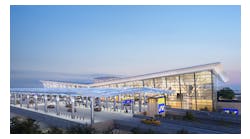A steep approach and unpredictable weather highlight what many pilots refer to as the ‘most extreme airport in the world’. Pilot and president of Icarus Jet, Kevin Singh, shares why flights to Aspen-Pitkin County Airport should be operated only by well—prepared and confident pilots.
Aspen, Colorado, is renowned for its stunning natural beauty, world-class ski resorts, and a lifestyle that attracts the rich and famous. But for those who own or charter private jets, flying into Aspen can be a daunting prospect. The reason? Aspen-Pitkin County Airport (ASE), also known as Sardy Field, is often ranked among the world's most challenging airports for private jet pilots due to various reasons.
In fact, the airport recently created a Flight Ops Safety Task Force, which presents eight distinct strategies aimed at enhancing safety at the airport, with a particular emphasis on three key initiatives deemed most critical: real-time wind data integration, a comprehensive pilot education and safety campaign, and the enhancement of instrument approach procedures. Yes, operating in Aspen is no walk in the park.
At an elevation of 7,820 feet above sea level, Aspen Airport is one of the highest airports in the United States. This high-altitude location poses several challenges for pilots of private jets, with reduced air density at high altitudes affecting aircraft performance while making takeoffs and landings more demanding. To make matters more interesting, Aspen's runway is relatively short, measuring just 8,006 feet, and this combination of high altitude and limited runway length requires precise maneuvering and skilled piloting.
The previous is especially noteworthy for the private aviation sector, considering that, according to an analysis by Aspen Journalism – using FAA data – air taxis account up 80% of the flights at Aspen-Pitkin County Airport. Furthermore, between 2021 and 2022, about 42% of the total 91,000 itinerant operations were attributed to general aviation, while 34% were associated with air taxi services. In contrast, air carriers, which encompass commercial flights provided by American and United Airlines and seasonally by Delta Air Lines, constituted less than one-quarter of the airport's total operations during the same timeframe.
Back to the operational challenges. One of the key factors that set Aspen Airport apart is its reliance on visual approaches. Unlike many other airports where instrument landing systems (ILS) guide aircraft in low-visibility conditions, Aspen does not have an ILS. This means that pilots must rely on their visual skills, onboard equipment, and communication with air traffic control to safely navigate the approach, particularly when weather conditions deteriorate during winter.
Pilot training
Little room for error might be an understatement. It’s not uncommon that pilots who are unfamiliar with the area are discouraged from operating during periods of low visibility, evidencing that more than the training, it’s the experience that takes a larger role when operating in Aspen. Although night operations are a no-no for the inexperienced, for those passengers and future pilots reading this piece, rest assured that tens of thousands of airplanes do land safely at the airport which highlights that, with appropriate established protocols, cautions, and the support of a professional trip support team, flying to Aspen is indeed safe.
In terms of what should be expected by pilots, Aspen's location in the Rocky Mountains hands down contributes to its reputation for unpredictable weather. Conditions can change rapidly, and the airport is prone to sudden snowstorms, fog, and high winds – these weather challenges require pilots to be prepared for quick shifts in conditions, with no second-guessing allowed, thus making each approach to Aspen a unique and demanding experience.
Furthermore, in terms of training, focusing on high-altitude preparation – understanding the impact of reduced air density on engine performance, flight dynamics, and aircraft systems – as well as grasping all aspects of mountain flying techniques, which may include coping with rapidly changing weather conditions, turbulence, and instantaneous wind patterns should be thoroughly studied during training.
Airport alternatives
Private aviation grants passengers the possibility to arrive and depart at almost any airstrip in the country. While Aspen-Pitkin County Airport is the natural option to land near one of the world’s most renowned ski centers, this industry does provide airport alternatives, something valuable, especially during peak season (December to March for skiing). Our trip support team at Icarus Jet works on a yearly basis with the following runway alternatives and has prepared the flight time and driving distances between other nearby airports to Aspen.
Your choice of an alternative airport will depend on your travel preferences, schedule, and, most importantly, the availability of slots at the runway. While Aspen Airport is the most convenient option, these alternatives can provide access to the region, and passengers can enjoy scenic drives while traveling to Aspen.
Aspen Airport, often labeled as one of the world's most challenging airports for private jets, continues to be a coveted destination for those who can meet its unique demands – the combination of high altitude, unpredictable weather, and visual approaches makes it a true test of a pilot's abilities.
Yet, those who prepare their operation accordingly and succeed in landing at Aspen, are rewarded with access to one of the most prestigious and glamorous destinations in the world. Whether an aircraft owner, pilot, or passenger, teaming up with experienced trip support companies like Icarus Jet, which understand the local regulations, weather, and all the moving parts of a challenging operation, is paramount for a seamless and hassle-free private aviation experience.
About the Author
Pilot, president, and founder of Icarus Jet, a leading global trip support and aircraft management company, Kevin Singh has flown globally as a chief pilot and captain on private jets like the Hawker 800-A and 850 XP, and the Challenger 600 series and Global 6000.




